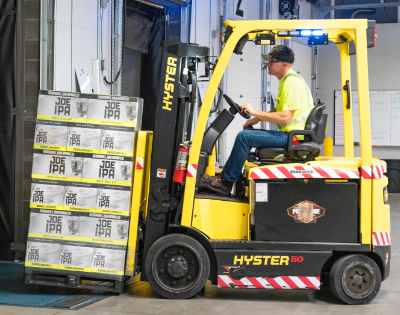Common problems working with vehicle loading and unloading.
Many businesses have forklift trucks on site. The loading and unloading of vehicles will most likely be one of its main functions. A forklift truck also has the potential to be one of the most dangerous hazards in the business.
The risk of accidents, injuries and fatalities increases whenever forklift trucks and pedestrians share the same working environment. It is therefore vital that the arrival of delivery drivers or pedestrians into loading areas is carefully managed.
Here, we look at some of the most common challenges faced in loading areas and some possible steps for keeping drivers and pedestrians at a safe distance.
Delivery driver too close to the forklift truck.
It shouldn’t be a surprise that many delivery drivers want to have an input on the loading process. It is after all, their responsibility to ensure the loads are secured correctly on their vehicle. They may also have a preferred loading order for unloading at the other end.
Whilst the delivery drivers can specify their loading requirements to enable smooth unloading at the receiving end, they should not be allowed in the loading area and must remain in a safe place whilst the forklift truck is in operation. Drivers may be tempted to try to assist the process by holding back a curtain, steadying a load or directing from alongside, but this puts them in danger should a load slip off or the forklift truck operator lose sight of them. The serious injuries caused by loading and unloading are almost always avoidable because the driver or pedestrian shouldn’t be in the area in the first place.
Such segregation measures are important because even if unsafe operating methods occur, they needn’t cause injuries to waiting drivers or pedestrians if safe distances are maintained. The HSE have lots of information on their website of what they expect in place regarding safe unloading and loading.
Risk reduction tip.
Make sure that there are suitable and sufficient segregation measures in place to keep delivery drivers and other pedestrians safe from forklift truck activity. Physical measures such as barriers can be used, in addition to pedestrian areas and painted walkways.
If safety policies and safe systems of work are in place, delivery drivers and pedestrians should never be in harms way.
No Safe System of Work in place for loading and unloading.
Risk assessments and the resulting Safe Systems of Work play a vital role in ensuring that all hazards associated with tasks such as loading and unloading are eliminated or the risks sufficiently minimised. Though Safe Systems of Work can significantly reduce the number of accidents on site, all too often, companies do not have these in place. Often, companies do actually have them in place but never communicate them to those exposed to the hazard.
Risk reduction tip.
Ensuring your Safe System of Work is established, communicated, and continually enforced by management, will reduce the risk of accidents on your site. Create a clear Safe System of Work for delivery drivers and make sure they are made aware of it when they come to your site. This could include having designated areas for drivers to safely wait or a key control system where drivers hand over their vehicle keys until loading and unloading is complete.
Safe Systems of Work are an important tool to keep your site safe, but are only effective if they are followed and communicated to those concerned.
Poor communication.
Safe Systems of Work may be in place but either they are not followed or not communicated to everyone who may be at risk, including visiting drivers. Managers have a responsibility to communicate Safe Systems of Work to everyone who could be affected, including visitors. This could be via safety meetings, training or signage etc. It is important that the workplace is regularly monitored to ensure adherence to Safe Systems of Work.
Risk reduction tip.
A simple control measure could be raising a hand to aid communication between forktruck drivers and pedestrians. Operators can use this to alert pedestrians if they are coming too close to the truck, and signal to them that they must stop. If they don’t stop, the driver must switch off the forktruck and apply the brake until it is safe to continue.
This is not an exhaustive list of the problems businesses face with loading and unloading vehicles. We suggest that companies take a look on the HSE’s website for further information.



